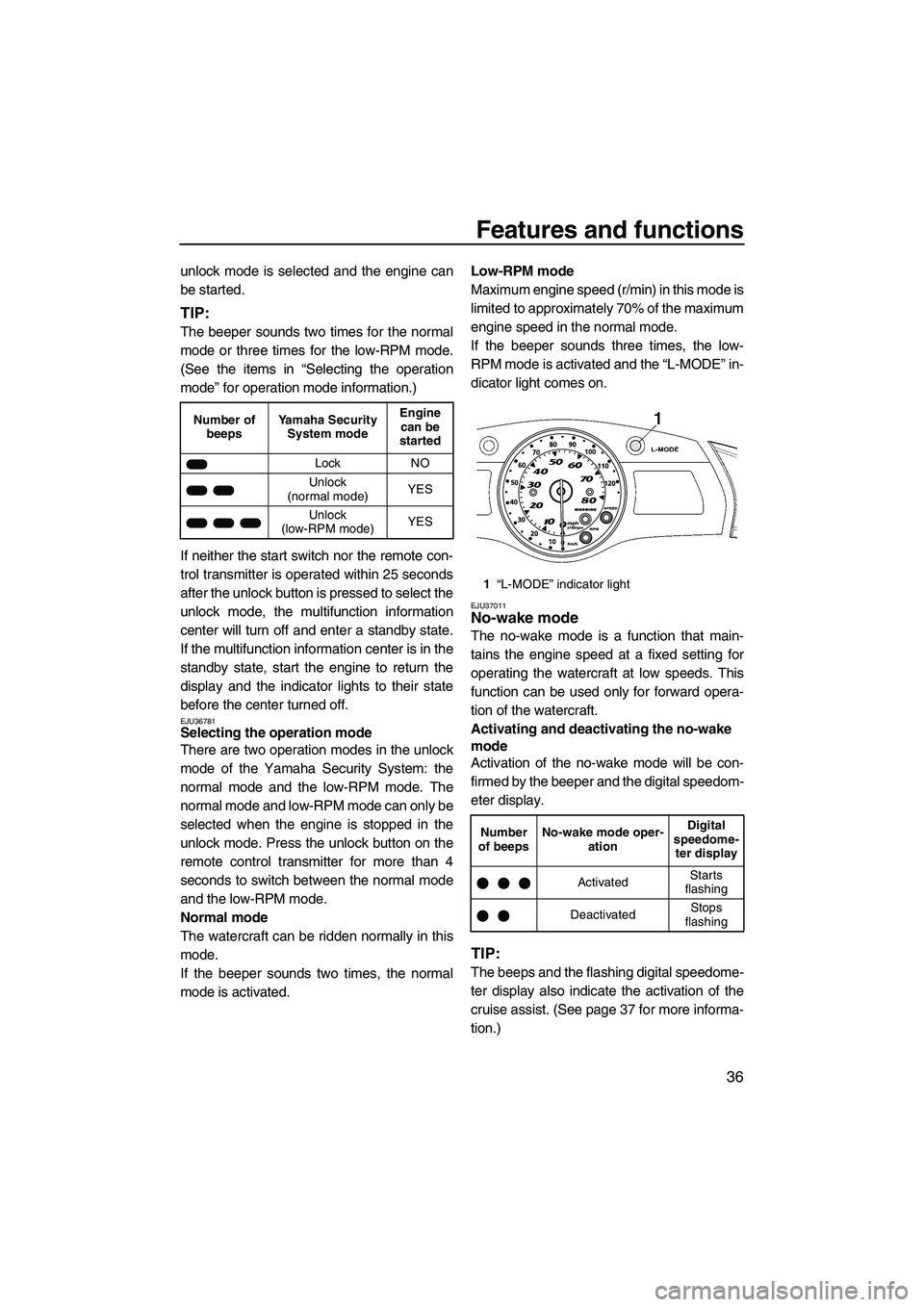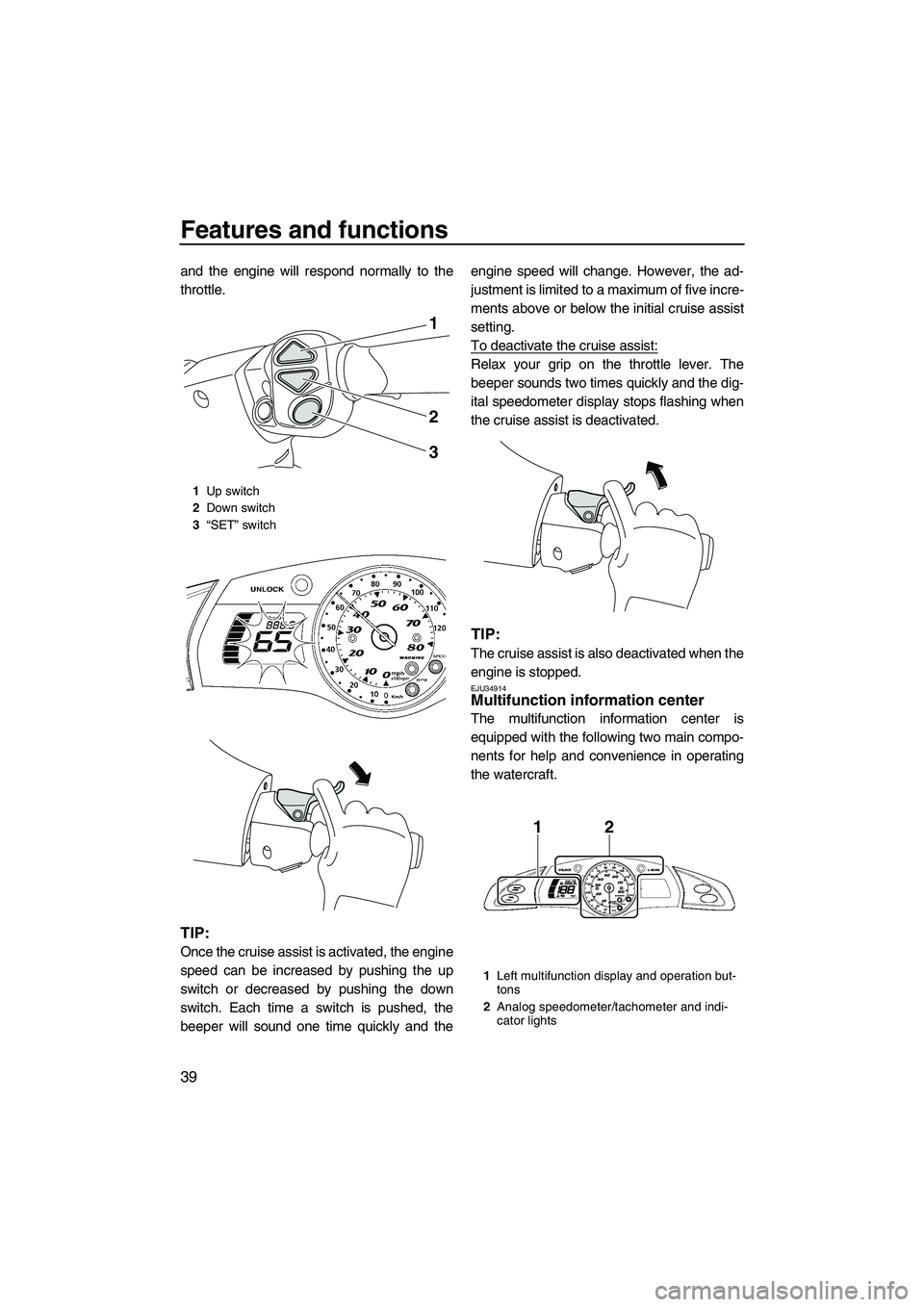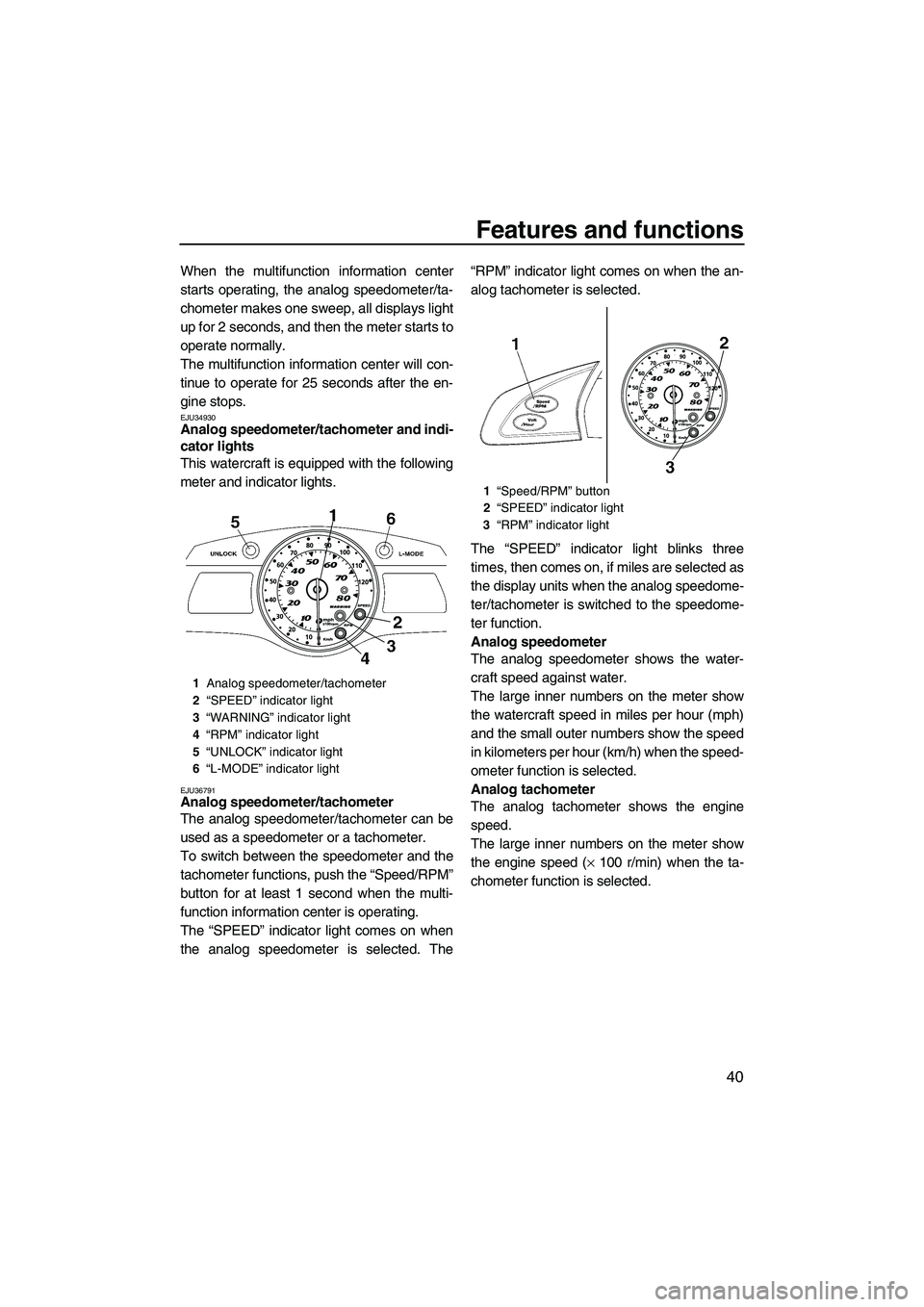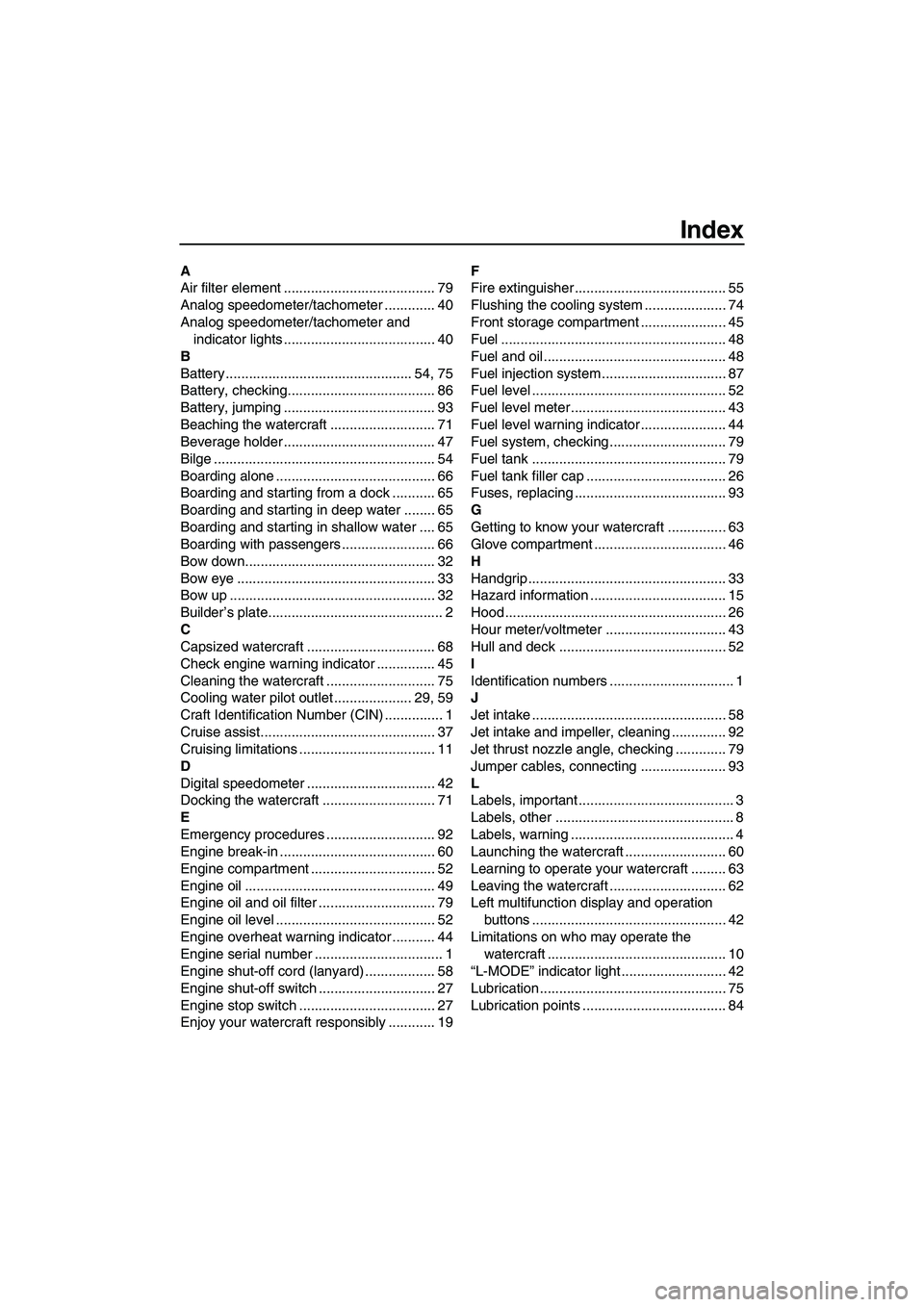2009 YAMAHA FX HO CRUISER lights
[x] Cancel search: lightsPage 43 of 106

Features and functions
36
unlock mode is selected and the engine can
be started.
TIP:
The beeper sounds two times for the normal
mode or three times for the low-RPM mode.
(See the items in “Selecting the operation
mode” for operation mode information.)
If neither the start switch nor the remote con-
trol transmitter is operated within 25 seconds
after the unlock button is pressed to select the
unlock mode, the multifunction information
center will turn off and enter a standby state.
If the multifunction information center is in the
standby state, start the engine to return the
display and the indicator lights to their state
before the center turned off.
EJU36781Selecting the operation mode
There are two operation modes in the unlock
mode of the Yamaha Security System: the
normal mode and the low-RPM mode. The
normal mode and low-RPM mode can only be
selected when the engine is stopped in the
unlock mode. Press the unlock button on the
remote control transmitter for more than 4
seconds to switch between the normal mode
and the low-RPM mode.
Normal mode
The watercraft can be ridden normally in this
mode.
If the beeper sounds two times, the normal
mode is activated.Low-RPM mode
Maximum engine speed (r/min) in this mode is
limited to approximately 70% of the maximum
engine speed in the normal mode.
If the beeper sounds three times, the low-
RPM mode is activated and the “L-MODE” in-
dicator light comes on.
EJU37011No-wake mode
The no-wake mode is a function that main-
tains the engine speed at a fixed setting for
operating the watercraft at low speeds. This
function can be used only for forward opera-
tion of the watercraft.
Activating and deactivating the no-wake
mode
Activation of the no-wake mode will be con-
firmed by the beeper and the digital speedom-
eter display.
TIP:
The beeps and the flashing digital speedome-
ter display also indicate the activation of the
cruise assist. (See page 37 for more informa-
tion.)
Number of
beepsYamaha Security
System modeEngine
can be
started
Lock NO
Unlock
(normal mode)YES
Unlock
(low-RPM mode)YES
1“L-MODE” indicator light
Number
of beepsNo-wake mode oper-
ationDigital
speedome-
ter display
ActivatedStarts
flashing
DeactivatedStops
flashing
UF2H70E0.book Page 36 Thursday, January 15, 2009 10:49 AM
Page 46 of 106

Features and functions
39
and the engine will respond normally to the
throttle.
TIP:
Once the cruise assist is activated, the engine
speed can be increased by pushing the up
switch or decreased by pushing the down
switch. Each time a switch is pushed, the
beeper will sound one time quickly and theengine speed will change. However, the ad-
justment is limited to a maximum of five incre-
ments above or below the initial cruise assist
setting.
To deactivate the cruise assist:
Relax your grip on the throttle lever. The
beeper sounds two times quickly and the dig-
ital speedometer display stops flashing when
the cruise assist is deactivated.
TIP:
The cruise assist is also deactivated when the
engine is stopped.
EJU34914Multifunction information center
The multifunction information center is
equipped with the following two main compo-
nents for help and convenience in operating
the watercraft.
1Up switch
2Down switch
3“SET” sw itch
1
2
3
1Left multifunction display and operation but-
tons
2Analog speedometer/tachometer and indi-
cator lights
12
UF2H70E0.book Page 39 Thursday, January 15, 2009 10:49 AM
Page 47 of 106

Features and functions
40
When the multifunction information center
starts operating, the analog speedometer/ta-
chometer makes one sweep, all displays light
up for 2 seconds, and then the meter starts to
operate normally.
The multifunction information center will con-
tinue to operate for 25 seconds after the en-
gine stops.
EJU34930Analog speedometer/tachometer and indi-
cator lights
This watercraft is equipped with the following
meter and indicator lights.
EJU36791Analog speedometer/tachometer
The analog speedometer/tachometer can be
used as a speedometer or a tachometer.
To switch between the speedometer and the
tachometer functions, push the “Speed/RPM”
button for at least 1 second when the multi-
function information center is operating.
The “SPEED” indicator light comes on when
the analog speedometer is selected. The“RPM” indicator light comes on when the an-
alog tachometer is selected.
The “SPEED” indicator light blinks three
times, then comes on, if miles are selected as
the display units when the analog speedome-
ter/tachometer is switched to the speedome-
ter function.
Analog speedometer
The analog speedometer shows the water-
craft speed against water.
The large inner numbers on the meter show
the watercraft speed in miles per hour (mph)
and the small outer numbers show the speed
in kilometers per hour (km/h) when the speed-
ometer function is selected.
Analog tachometer
The analog tachometer shows the engine
speed.
The large inner numbers on the meter show
the engine speed (× 100 r/min) when the ta-
chometer function is selected.
1Analog speedometer/tachometer
2“SPEED” indicator light
3“WARNING” indicator light
4“RPM” indicator light
5“UNLOCK” indicator light
6“L-MODE” indicator light
1“Speed/RPM” button
2“SPEED” indicator light
3“RPM” indicator light
UF2H70E0.book Page 40 Thursday, January 15, 2009 10:49 AM
Page 103 of 106

Index
A
Air filter element ....................................... 79
Analog speedometer/tachometer ............. 40
Analog speedometer/tachometer and
indicator lights ....................................... 40
B
Battery ................................................ 54, 75
Battery, checking...................................... 86
Battery, jumping ....................................... 93
Beaching the watercraft ........................... 71
Beverage holder ....................................... 47
Bilge ......................................................... 54
Boarding alone ......................................... 66
Boarding and starting from a dock ........... 65
Boarding and starting in deep water ........ 65
Boarding and starting in shallow water .... 65
Boarding with passengers ........................ 66
Bow down................................................. 32
Bow eye ................................................... 33
Bow up ..................................................... 32
Builder’s plate............................................. 2
C
Capsized watercraft ................................. 68
Check engine warning indicator ............... 45
Cleaning the watercraft ............................ 75
Cooling water pilot outlet .................... 29, 59
Craft Identification Number (CIN) ............... 1
Cruise assist............................................. 37
Cruising limitations ................................... 11
D
Digital speedometer ................................. 42
Docking the watercraft ............................. 71
E
Emergency procedures ............................ 92
Engine break-in ........................................ 60
Engine compartment ................................ 52
Engine oil ................................................. 49
Engine oil and oil filter .............................. 79
Engine oil level ......................................... 52
Engine overheat warning indicator ........... 44
Engine serial number ................................. 1
Engine shut-off cord (lanyard) .................. 58
Engine shut-off switch .............................. 27
Engine stop switch ................................... 27
Enjoy your watercraft responsibly ............ 19F
Fire extinguisher ....................................... 55
Flushing the cooling system ..................... 74
Front storage compartment ...................... 45
Fuel .......................................................... 48
Fuel and oil............................................... 48
Fuel injection system ................................ 87
Fuel level .................................................. 52
Fuel level meter ........................................ 43
Fuel level warning indicator ...................... 44
Fuel system, checking .............................. 79
Fuel tank .................................................. 79
Fuel tank filler cap .................................... 26
Fuses, replacing ....................................... 93
G
Getting to know your watercraft ............... 63
Glove compartment .................................. 46
H
Handgrip ................................................... 33
Hazard information ................................... 15
Hood ......................................................... 26
Hour meter/voltmeter ............................... 43
Hull and deck ........................................... 52
I
Identification numbers ................................ 1
J
Jet intake .................................................. 58
Jet intake and impeller, cleaning .............. 92
Jet thrust nozzle angle, checking ............. 79
Jumper cables, connecting ...................... 93
L
Labels, important ........................................ 3
Labels, other .............................................. 8
Labels, warning .......................................... 4
Launching the watercraft .......................... 60
Learning to operate your watercraft ......... 63
Leaving the watercraft .............................. 62
Left multifunction display and operation
buttons .................................................. 42
Limitations on who may operate the
watercraft .............................................. 10
“L-MODE” indicator light ........................... 42
Lubrication................................................ 75
Lubrication points ..................................... 84
UF2H70E0.book Page 1 Thursday, January 15, 2009 10:49 AM